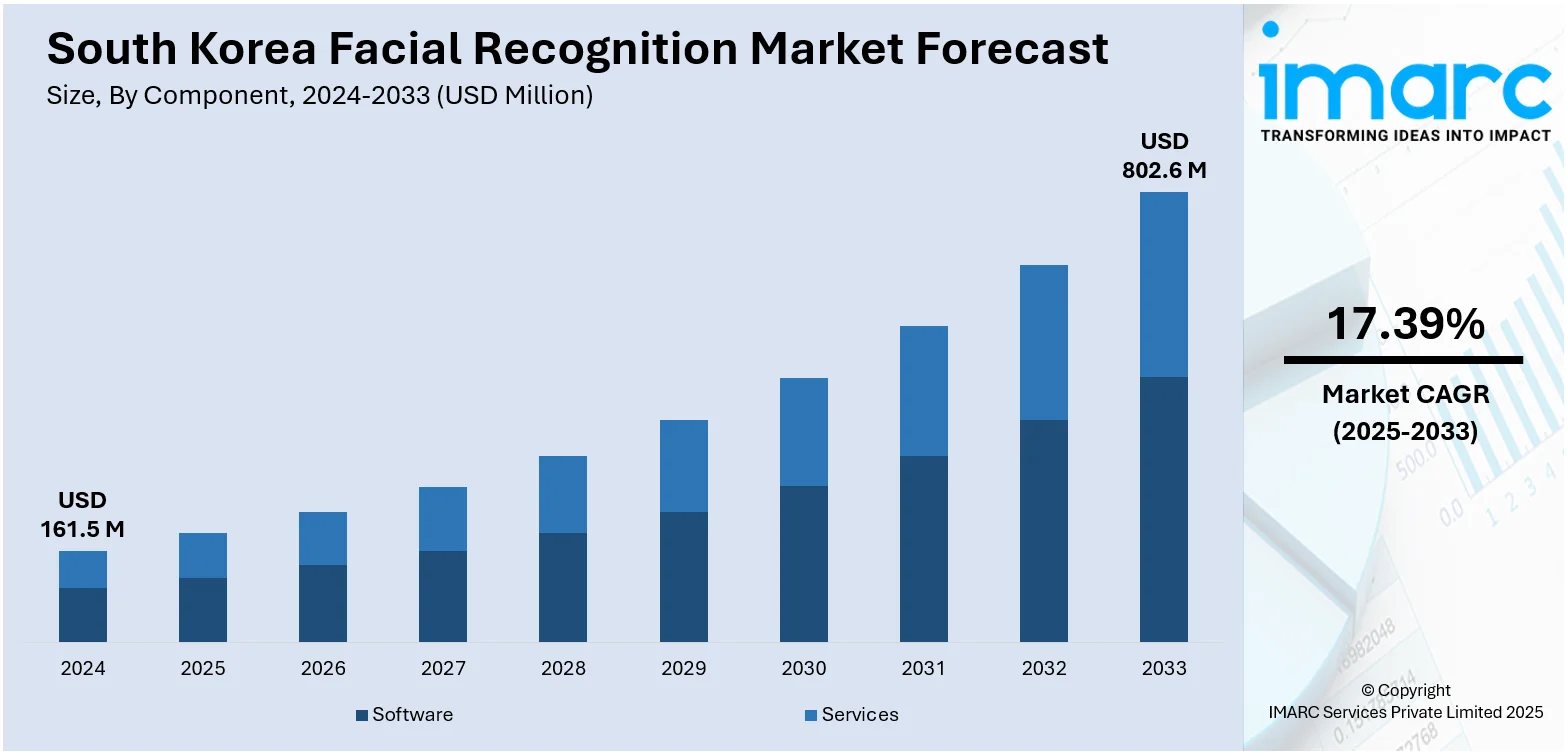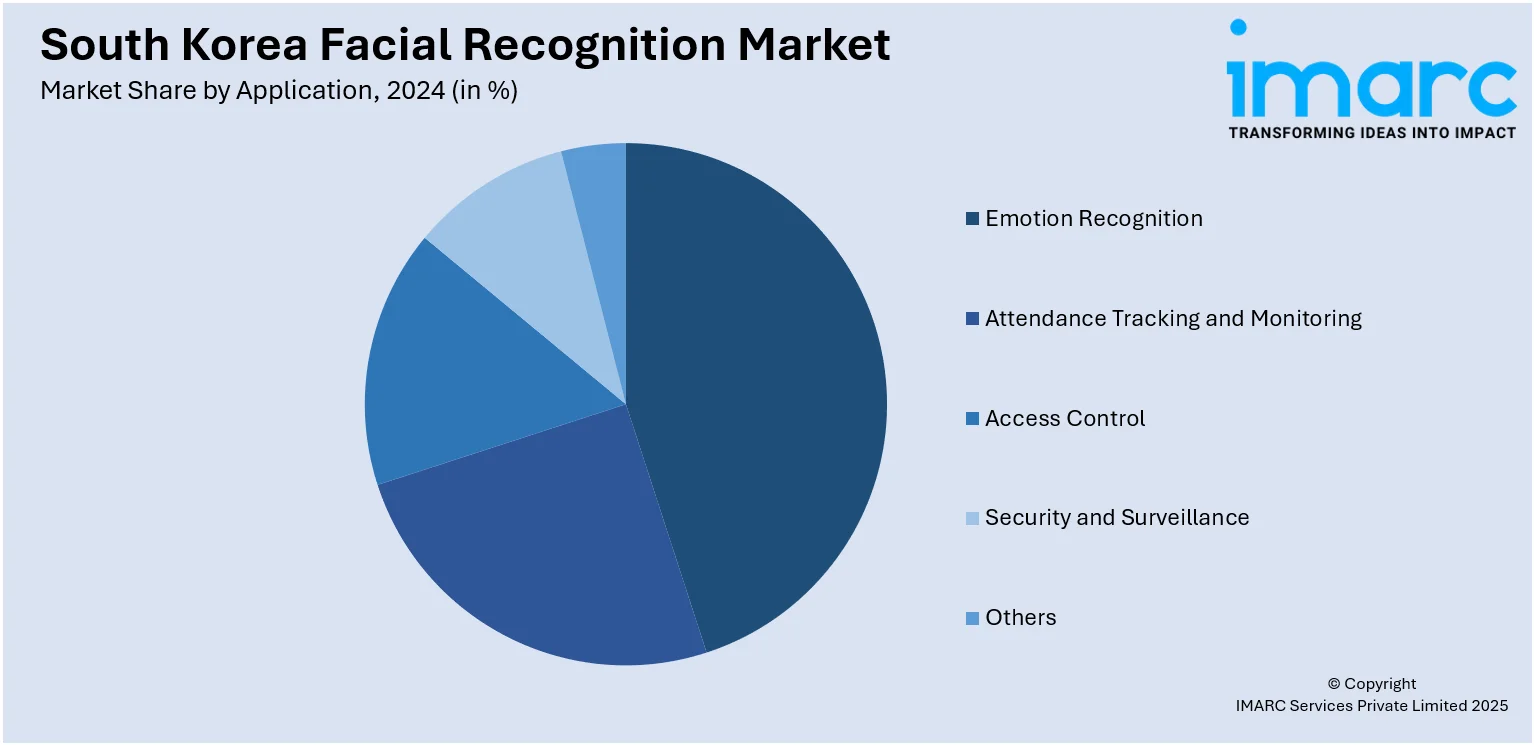
South Korea Facial Recognition Market Size, Share, Trends and Forecast by Component, Technology, Application, End Use Industry, and Region, 2025-2033
South Korea Facial Recognition Market Overview:
The South Korea facial recognition market size reached USD 161.5 Million in 2024. The market is projected to reach USD 802.6 Million by 2033, exhibiting a growth rate (CAGR) of 17.39% during 2025-2033. The market is seeing significant growth due to widespread adoption in markets like security, retail, and banking. Improvements in AI and machine learning technologies are raising system accuracy and efficiency, leading to increased adoption. As applications grow for both public and private domains, stakeholders are concerned with innovation and integration to stay ahead in the changing dynamics of the South Korea facial recognition market share.
|
Report Attribute
|
Key Statistics
|
|---|---|
|
Base Year
|
2024 |
|
Forecast Years
|
2025-2033
|
|
Historical Years
|
2019-2024
|
| Market Size in 2024 | USD 161.5 Million |
| Market Forecast in 2033 | USD 802.6 Million |
| Market Growth Rate 2025-2033 | 17.39% |
South Korea Facial Recognition Market Trends:
Enhanced AI-Driven Surveillance in Public Transit Systems
In February 2025, Seoul Metro significantly upgraded its security infrastructure by deploying more than 20,000 surveillance cameras equipped with AI analytics across 276 stations, protecting nearly 7 million daily passengers. The system integrates facial recognition technology with 3D mapping and IoT sensors to enable real-time monitoring and faster emergency response. This AI-powered approach has led to a notable reduction in incident response times, improving passenger safety and operational efficiency. By combining video analytics and digital twin technology, Seoul Metro can better manage crowds and detect anomalies promptly. The system also respects privacy through secure data management protocols. This large-scale adoption of biometric authentication in public transportation reflects South Korea’s commitment to modernizing infrastructure through smart technologies. These advancements serve as key drivers in the South Korea facial recognition market trends, demonstrating how government-led innovation in urban transit is accelerating the adoption of facial recognition solutions and shaping the broader biometric technology landscape.

To get more information on this market, Request Sample
Expansion into Retail and Finance
The expansion of facial recognition payment solutions in South Korea indicates market growth as these systems transition from surveillance to mainstream consumer use. In February 2025, the major convenience store chains CU, GS25, and 7‑Eleven piloted “FacePay,” a Toss‑powered facial payment service that registers users’ faces in the Toss app and enables touchless checkout by scanning their face at terminals. With authentication accuracy of 99.99 percent and response time of under one second, this deployment highlights both consumer convenience and technological maturity. As trials extend into cinemas, cafes, ATMs, and kiosks, more interaction points are adopting biometric verification. The move demonstrates deepening consumer acceptance and willingness to trade conventional methods for speed and hygiene. Financial institutions and retailers are leveraging this momentum to embed facial recognition in user‑facing services, creating a seamless biometric ecosystem. The rapid deployment in retail exemplifies how South Korea is integrating identity authentication into everyday transactions. Analysts suggest that as infrastructure scales and regulatory frameworks evolve, more sectors will incorporate this form of biometric authentication, reinforcing steady South Korea facial recognition market growth.
Government Support and Smart City Integration
Government initiatives are playing a crucial role in advancing facial recognition technology in South Korea by fostering innovation and regulatory frameworks that support its safe deployment. In September 2024, the National Artificial Intelligence Committee was formed to oversee AI and biometric strategies across industries, ensuring coordinated policy development and responsible technology use. This committee’s efforts align with the country’s smart city projects, which integrate facial recognition into public infrastructure, including airports and transit systems. A notable example is Incheon International Airport, where automated boarding and immigration processes use facial recognition to speed up passenger flow and enhance security. In parallel, investments in AI semiconductors and edge computing hardware have strengthened the technical ecosystem. This comprehensive approach, combining regulatory oversight, public deployment, and infrastructure enhancement positions South Korea as a front-runner in biometric innovation, balancing technological advancement with privacy and security considerations. These coordinated actions support sustainable, long-term adoption of facial recognition solutions across various sectors.
South Korea Facial Recognition Market Segmentation:
IMARC Group provides an analysis of the key trends in each segment of the market, along with forecasts at the country and regional levels for 2025-2033. Our report has categorized the market based on component, technology, application, and end use industry.
Component Insights:
- Software
- Services
The report has provided a detailed breakup and analysis of the market based on the component. This includes software and services.
Technology Insights:
- 2D Facial Recognition
- 3D Facial Recognition
- Facial Analytics
A detailed breakup and analysis of the market based on the technology have also been provided in the report. This includes 2D facial recognition, 3D facial recognition, and facial analytics.
Application Insights:

- Emotion Recognition
- Attendance Tracking and Monitoring
- Access Control
- Security and Surveillance
- Others
The report has provided a detailed breakup and analysis of the market based on the application. This includes emotion recognition, attendance tracking and monitoring, access control, security and surveillance, and others.
End Use Industry Insights:
- Retail and E-commerce
- BFSI
- Government and Defense
- Automotive and Transportation
- Media and Entertainment
- Healthcare
- Telecom and IT
- Others
A detailed breakup and analysis of the market based on the end use industry have also been provided in the report. This includes retail and e-commerce, BFSI, government and defense, automotive and transportation, media and entertainment, healthcare, telecom and IT, and others.
Regional Insights:
- Seoul Capital Area
- Yeongnam (Southeastern Region)
- Honam (Southwestern Region)
- Hoseo (Central Region)
- Others
The report has also provided a comprehensive analysis of all the major regional markets, which include the Seoul Capital Area, Yeongnam (Southeastern Region), Honam (Southwestern Region), Hoseo (Central Region), and others.
Competitive Landscape:
The market research report has also provided a comprehensive analysis of the competitive landscape. Competitive analysis such as market structure, key player positioning, top winning strategies, competitive dashboard, and company evaluation quadrant has been covered in the report. Also, detailed profiles of all major companies have been provided.
South Korea Facial Recognition Market News:
- May 2025: Meta has gained approval from South Korea’s Personal Information Protection Commission (PIPC) for its facial recognition-based service aimed at curbing celebrity impersonation in advertisements and social media. The platform allows authorised public figures to register their facial data, which Meta uses to detect and block ads or accounts mimicking them, including deepfakes. Data is processed only once, deleted immediately after comparison, and includes human oversight and user objection options reflecting Meta’s efforts to align with national privacy standards. The PIPC will continue monitoring implementation to ensure compliance.
- February 2025: South Korea's fintech pioneer Toss is leading the way in adopting facial recognition tech in the nation's financial sector, improving security and convenience for users. The firm has launched its FacePay system, which allows users to register via the Toss app and make payments at convenience store chains such as CU, GS25, and 7‑Eleven by scanning their faces once. The step fits with South Korea's overall transition to digital identity and contactless verification, a major milestone in the country's biometric evolution.
South Korea Facial Recognition Market Report Coverage:
| Report Features | Details |
|---|---|
| Base Year of the Analysis | 2024 |
| Historical Period | 2019-2024 |
| Forecast Period | 2025-2033 |
| Units | Million USD |
| Scope of the Report | Exploration of Historical Trends and Market Outlook, Industry Catalysts and Challenges, Segment-Wise Historical and Future Market Assessment:
|
| Components Covered | Software, Services |
| Technologies Covered | 2D Facial Recognition, 3D Facial Recognition, Facial Analytics |
| Applications Covered | Emotion Recognition, Attendance Tracking and Monitoring, Access Control, Security and Surveillance, Others |
| End Use Industries Covered | Retail and E-commerce, BFSI, Government and Defense, Automotive and Transportation, Media and Entertainment, Healthcare, Telecom and IT, Others |
| Regions Covered | Seoul Capital Area, Yeongnam (Southeastern Region), Honam (Southwestern Region), Hoseo (Central Region), Others |
| Customization Scope | 10% Free Customization |
| Post-Sale Analyst Support | 10-12 Weeks |
| Delivery Format | PDF and Excel through Email (We can also provide the editable version of the report in PPT/Word format on special request) |
Key Questions Answered in This Report:
- How has the South Korea Facial Recognition market performed so far and how will it perform in the coming years?
- What is the breakup of the South Korea Facial Recognition market on the basis of component?
- What is the breakup of the South Korea Facial Recognition market on the basis of technology?
- What is the breakup of the South Korea Facial Recognition market on the basis of application?
- What is the breakup of the South Korea Facial Recognition market on the basis of end use industry?
- What is the breakup of the South Korea Facial Recognition market on the basis of region?
- What are the various stages in the value chain of the South Korea Facial Recognition market?
- What are the key driving factors and challenges in the South Korea Facial Recognition?
- What is the structure of the South Korea Facial Recognition market and who are the key players?
- What is the degree of competition in the South Korea Facial Recognition market?
Key Benefits for Stakeholders:
- IMARC’s industry report offers a comprehensive quantitative analysis of various market segments, historical and current market trends, market forecasts, and dynamics of the South Korea Facial Recognition market from 2019-2033
- The research report provides the latest information on the market drivers, challenges, and opportunities in the South Korea Facial Recognition market.
- Porter's five forces analysis assist stakeholders in assessing the impact of new entrants, competitive rivalry, supplier power, buyer power, and the threat of substitution. It helps stakeholders to analyze the level of competition within the South Korea Facial Recognition industry and its attractiveness.
- Competitive landscape allows stakeholders to understand their competitive environment and provides an insight into the current positions of key players in the market.
Need more help?
- Speak to our experienced analysts for insights on the current market scenarios.
- Include additional segments and countries to customize the report as per your requirement.
- Gain an unparalleled competitive advantage in your domain by understanding how to utilize the report and positively impacting your operations and revenue.
- For further assistance, please connect with our analysts.
 Request Customization
Request Customization
 Speak to an Analyst
Speak to an Analyst
 Request Brochure
Request Brochure
 Inquire Before Buying
Inquire Before Buying




.webp)




.webp)












